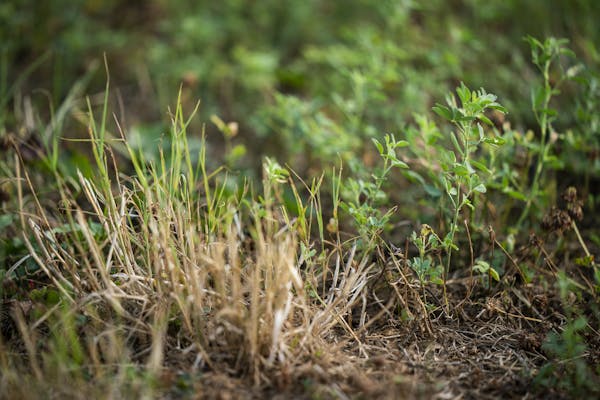CANNON FALLS, Minn. — U.S. Secretary of Agriculture Tom Vilsack visited Minnesota farmers Thursday as the state descended deeper into drought.
For the first time all summer, a portion of the state, stretching from Crookston to International Falls in northwest Minnesota, crossed the threshold into the worst drought stage — "exceptional" — according to the U.S. Department of Agriculture's Drought Monitor updated Thursday.
And Minnesota is not alone. The Northern Plains and everywhere west of the Rocky Mountains is in a drought, exacerbating market conditions for local cattle ranchers and dairy farmers as row-crop farmers hope for August rain to rejuvenate their fields.
"This is an unusual circumstance here in Minnesota, but is unfortunately across the western United States at a level we, frankly, haven't seen before," Vilsack told a group of Minnesota farm leaders gathered at Callister Farm near Cannon Falls.
Forty-two percent of Minnesota lands are now viewed to be in extreme drought, the level just below exceptional. That's up from 35% just last week.
Cattle ranchers and dairy farmers were the first and hardest hit by this summer's unusually hot and dry weather that scorched grazing pastures. Last month alone, Minnesota lost 21 dairy farms that had to sell off herds to stymie financial losses. Gov. Tim Walz said last week Minnesota will receive $17 million in federal aid to help drought-plagued farmers.
Grant Breitkreutz, president of Minnesota State Cattlemen's Association and a regional advocate for regenerative agriculture practices, drove from Redwood Falls Thursday morning to implore Vilsack, Sens. Tina Smith and Amy Klobuchar and Rep. Angie Craig to do whatever they could to help cattle farmers.
"The [federal] programs will help some of the producers, but they aren't enough to help all of the farmers," Breitkreutz said.
The main issue for livestock growers is hay feed, which farmers are now relying on more since pasture grasses aren't replenishing due to dry conditions. Minnesota farmers would typically be on their third round of hay harvesting at this point in the summer, but many never completed a first round.
Without food for the animals, cattle ranchers have been downsizing herds.
On his two-and-a-half-hour drive, Breitkreutz spoke with a cattle farmer who just got back from a sale barn in North Dakota that accepted 4,000 head of cattle. "Then they locked the doors and turned away a thousand cows," he said.
There's not enough pen space or slaughter capacity now, said Kevin Paap, president of the Minnesota Farm Bureau.
Breitkreutz sold 80 cows this spring to a young neighbor needing cattle, leaving himself with a smaller herd of 110 cow-calf pairs.
"If we hadn't sold off those cattle earlier this spring, we'd be a lot worse," he said. "We got a fair price but now they are hugely discounted."
Many ranchers selling their herds at a discount are losing their lifetime of genetics breeding and leaving farming behind.
Others who are in a slightly less-dry region, like William "Chip" Callister, who hosted Thursday's event, are dipping into their winter feed supply.
Breitkreutz said there's no hay within a 500-mile radius and asked the visiting politicians to temporarily allow them to graze their lands regulated under the USDA's conservation reserve program (CRP) without penalty.
Smith, Klobuchar and Craig said they support efforts to give Vilsack greater flexibility in opening up CRP land that may not consistently hit all of the requirements.
"The haying and grazing [issue] is obvious. The cost of hay is also a problem. We've advocated for using the CRP lands for early haying," Klobuchar said.
Certain CRP land in severe drought territory (classified as D2) is open for haying and grazing after Aug. 1 when the primary nesting season ends. But ranchers say it's not that simple as some CRP land bounces on a week-by-week basis between severe (D2) and extreme (D3) drought classification.
"I heard this all last week at Farmfest," Craig said, referring to the giant ag show near Morgan. "Ranchers ... were saying they thought they'd make it to [the] August 1 primary nesting date, but then the designation changed from D2 to D3 or D3 to D2 — for a minute — and that didn't really help them feed their cows."
Crops may be a mixed bag this year depending on where they are located within the state. Corn and soybeans, the state's principal crops, are generally in a stronger position because the dry spring led to deeper roots as they reached for more soil moisture, Paap said. Farmers worry that without more rain this fall soil won't have as much reserve moisture for next year's crops.
"This is an immediate and urgent challenge that needs to be addressed right now," Smith said, "but it's going to have ripple effects for coming years as water levels draw down."
